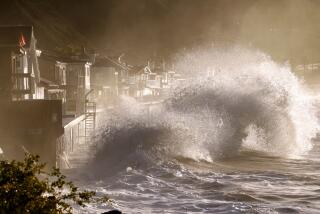Could Aid in Prediction of Destructive Flow : Current Shift May Signal ‘El Nino’ End
- Share via
WASHINGTON — Scientists studying the elusive course of “El Nino” have detected a shift in ocean current that may signal the end of the oceanic and atmospheric event that can wreak havoc on Pacific coastlands.
Michael McPhaden, a research oceanographer at the National Oceanic and Atmospheric Administration’s laboratory in Seattle, recently reported he found the equatorial undercurrent reversed its flow in the Western Pacific about two months before the end of the 1986-87 El Nino.
Mystery of Origin
“One big unsolved problem is what begins El Nino and another is what terminates it,” McPhaden said in a telephone interview. “In a consistent theory, the end point may have some significance in determining how El Nino begins again.”
El Nino events, which recur every four to seven years, warm coastal waters in western North and South America and bring massive rains to Pacific Coast regions. But at the same time, El Nino cools coastal waters in Australia and Indonesia and can produce severe droughts in those countries. Such dramatic fluctuations in weather patterns can inflict tremendous harm on agriculture and ocean fisheries.
Normally, the equatorial undercurrent, which is about 275 miles wide and spans the breadth of the Pacific, flows eastward along the Equator at about 1 m.p.h. But in September-October 1987, the current stream 130 nautical miles west of the western Pacific island of Nauru was measured flowing westward at about a half-mile an hour, McPhaden said.
At first, McPhaden thought something must be wrong with the meters NOAA uses to measure the current, which courses about 150 to 800 feet below the ocean surface. But a double-check of the instruments revealed the current was indeed running in reverse.
“This is the first information of its kind in the western Pacific region, where we think a lot of the crucial processes for developing El Nino take place,” McPhaden said.
The oceanographer noted the current changes were not only observed in surface water, but were found up to 800 feet below the surface.
McPhaden theorized the September-October shift may be linked to the end of the latest El Nino event, which drew to a close in January-February of this year.
McPhaden said current shifts have previously been detected in the eastern Pacific earlier in El Nino’s cycle.
Many scientists theorize El Nino is related to a circulation pattern of the Pacific’s air and water, in which westward trade winds weaken allowing the warm pool of surface water usually found west of the international date line to shift substantially to the east, McPhaden said.
Dramatic Changes
After studying the latest current shift, the oceanographer speculated the large volume of water moving west along the Equator indicated the current was carrying warm water displaced earlier back toward the west.
“It’s hard to judge its exact significance,but we have seen some current changes that were very dramatic and somewhat unexpected occurring toward the end of El Nino. We think there may be a connection there,” McPhaden said.
“The more we learn about El Nino in all of its phases, the better off we will be in terms of trying to predict it.”
More to Read
Sign up for Essential California
The most important California stories and recommendations in your inbox every morning.
You may occasionally receive promotional content from the Los Angeles Times.










